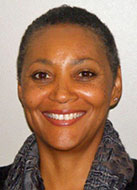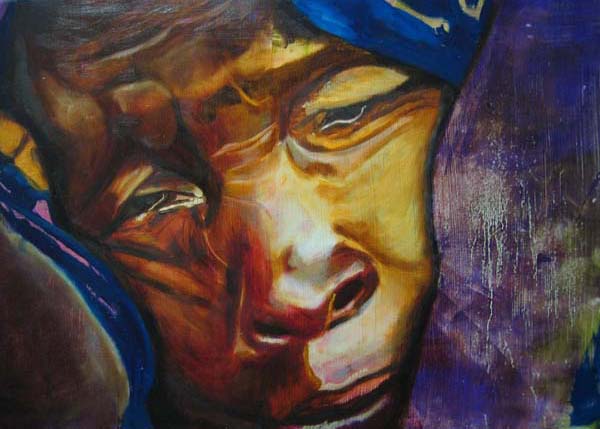Black Art and Social Justice: An Interview with Elizabeth Burden

In May 1967, Black Panther newspaper began incorporating “revolutionary art,” including drawings, political cartoons, and mixed-media images to “enlighten” and “educate” their members and the masses alike. My mother Elizabeth Burden, a visual artist, consultant, and activist, operates in this tradition. Her work examines and interprets the conjunctures of Blackness, justice, and structures of domination. Such deep engagement through the arts is an essential part of the long Black Liberation struggle, and is thus worth highlighting.
 Elizabeth Burden is a multidisciplinary artist whose works use drawing, painting, sculpture, video, coding, mapping, and social practice to interpret and reinterpret personal, community, and societal narratives about identity, memory, belonging, (dis)placement, (in)visibility, erasure, and the unspoken. She is also the Chief Executive and Creative Officer for Participation INK, which uses creative processes to encourage visionary, disruptive, and radical thinking in both informal groups and formal organizations. She provides consulting services in organizational development, strategic planning, program planning and evaluation, curriculum development, and facilitation. The common thread that runs through all her work is to look at old realities anew, to confront those realities, reflect upon them, shape them, and transform them. Burden holds bachelor’s degrees in Journalism and Studio Art, and a master’s degree in Geographic Information Science.
Elizabeth Burden is a multidisciplinary artist whose works use drawing, painting, sculpture, video, coding, mapping, and social practice to interpret and reinterpret personal, community, and societal narratives about identity, memory, belonging, (dis)placement, (in)visibility, erasure, and the unspoken. She is also the Chief Executive and Creative Officer for Participation INK, which uses creative processes to encourage visionary, disruptive, and radical thinking in both informal groups and formal organizations. She provides consulting services in organizational development, strategic planning, program planning and evaluation, curriculum development, and facilitation. The common thread that runs through all her work is to look at old realities anew, to confront those realities, reflect upon them, shape them, and transform them. Burden holds bachelor’s degrees in Journalism and Studio Art, and a master’s degree in Geographic Information Science.
Charisse Burden-Stelly: What does the “Black” in Black artist mean to you? Does “Black art” exist, and if so, how would you describe or define it?
Elizabeth Burden: To me, the “Black” in Black artist means four things: a cultural heritage (a person of African heritage); a political consciousness; a particular positionality; and a racialized categorization. Each of these modifies the term artist — a person who practices any of the various creative or plastic arts — in different ways, which informs my response to your second question.
Black art does not exist, but Black arts do.
There are artworks that enact, reflect, represent, and transmit heritage, which are an aesthetic of identity. There is artistic production that is politically engaged, producing art and artifacts that evoke conflicts about power and its uses/abuses that is an aesthetic of social justice. There are works that embrace the unique position of Blackness, negate it, or confront it, reflecting an aesthetic of subjectivity. There are works that explore the meaning of Blackness, whiteness, or other –nesses as an aesthetic of ontology. And there are works that reflect none of the above, in essence an aesthetic of pure aesthetics. These are all Black arts.
Burden-Stelly: Does the Black artist have an ethical or moral responsibility to produce work that excavates, reveals, and/or challenges the structures of domination that affect the lived conditions of Black people?
Burden: Just being Black, having the temerity to proclaim oneself a working artist challenges the structures of domination. At the same time it also capitulates to those structures.
The only responsibility that a Black artist has is to make art. However, I believe for any thinking Black person who is also an artist, it is difficult to make art following an aesthetic of pure aesthetics. One of the other four aesthetics, or a combination of them, are given form in tangible or visible works about the lived conditions and complexities of Black people. One or more of the meanings of “Black” described previously will make its way into his, her, their, or zir artistic practice.
My current artmaking vacillates between the Black aesthetics as I have defined them. Others have tried to define my work as being about other things: the universality of suffering, the capriciousness of life, the resilience of humanity; dualities, dichotomies, displacements, and disparities; bearing witness. It is all of those and none of them.
For me, I create primarily figurative works. The persons I choose to represent are predominantly Black or brown, and the subjects I respond to are those that challenge me personally; that challenge my thinking, feeling, or being.

Burden-Stelly: How does your art capture the dialectic between Black people’s oppression and dispossession, and their resistance, joy, and striving?
Burden: The tools that I use as a visual artist are content, form, media, and process or technique.
In content, I sometimes directly address that dialectic, for example, in a series of diptychs I called When We Were/ Not, the works consider six eras of American history, each defined based on the predominant term used for people of African heritage during the period. The sinister panels interpreted well known incidents of oppression and dispossession, while the dexter panels presented portraits from the same period of my forebears enjoying their lives.
Other times the content is more subdued and it is the form or media that capture the dialectic. In an installation entitled Palimpsests: My Great Grandfather’s House, I invite the viewer to look into and through a facsimile of the house my great grandfather built as the first Black homesteader in Nebraska in 1868. He built his home, found a wife, farmed, raised a family, and helped to transform the “wilderness.” His story engenders family pride. It also raises questions: What histories are unrecognized, unspoken, or erased to make space for my family’s narrative? What sins have been forgotten to allow for pride, the original and most serious of the seven deadly sins? In this installation, I recreated my great grandfather’s house to scale using translucent and transparent ephemeral materials along with sound and photos from historical archives and my personal family photo archive. Each component added a different dimension to a complete tableau, considering the layers of history.
Still other times it is in the process that the dialectic is foregrounded. The piece One is a Dinner Guest, is a set of instructions for two different social gatherings. The process of enacting captures delectation and dispossession, recreation and resistance.
Burden-Stelly: Can you describe the different types of media you use in your art? How does each help you capture a specific form of expression? Do you have a favorite approach?
Burden: I use a variety of media and techniques. Pretty much any material that can be used to make a physical object through drawing, painting, sculpture, video, coding, mapping, and social practices. I don’t have a favorite; each has a different quality, embedded meaning, and purpose. For example, painting has a particular gravitas as a so-called fine art, but is static. Video is dynamic, but often people will only attend to a short segment. I try to match the media to the intent of the piece. Artmaking is a process of problem solving, thinking through what I want to convey, exploring different possible means of conveyance, and ultimately deciding on the one that resolves most successfully.
Burden-Stelly: What would you say is the unique intervention of visual art and culture as opposed to literary or written work? What themes, messages, and ideas are you able to convey through visual art that evade the written word?
Burden: I don’t think that there are themes or ideas that can be conveyed only visually. I think visual art and literature are symbiotic. Carefully crafted words evoke visuals while visual art can be described and interpreted in writing. Often my work is initiated because of something that I have read, such as a particular word or phrase that makes me pause or prompts reflection.
I guess this begs the question, “Why not just write?”
I think the visual gives us a seemingly easy way into a subject. If one lingers with a visual artwork, it prompts us to lookcarefully and deeply—to observe—before moving into a process of making meaning—to interpret. In critique, I ask people to first carefully describe what they see objectively before they share what it makes them think or feel. It is often challenging for individuals to do because they want to jump right into their opinion, but when we take the time to observe we begin to see things that we didn’t before. We find juxtapositions that lead us to ask questions about what it is that we see and we uncover deeper layers of meaning.
Copyright © AAIHS. May not be reprinted without permission.
The Lamentation oil painting is too deep for words.